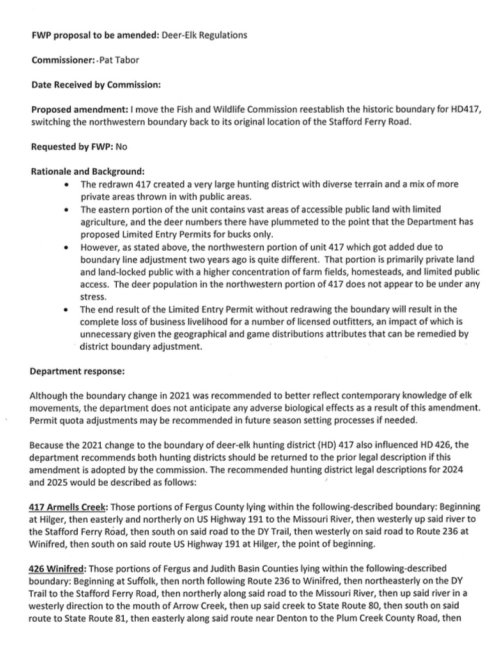rogerthat
Well-known member
- Joined
- Aug 29, 2015
- Messages
- 3,458
Interesting to include the bma lands. That might be a poison pill. Landowners enrolling in block should get the decision just like any other land owner
Follow along with the video below to see how to install our site as a web app on your home screen.
Note: This feature may not be available in some browsers.
Interesting to include the bma lands. That might be a poison pill. Landowners enrolling in block should get the decision just like any other land owner
Fwp will tell you even 11,000 mule deer doe tags has no effect on the population. The only reason for cutting numbers last two years was a feel good for the public according to themBased on FWP‘s “harvest report,” 4,482 mule deer does were killed from 2021-2022. To me that seems like a shit load of deer for one region and reducing that to zero would absolutely have a positive effect on the population, but I’m not a biologist
Their harvest report isn’t showing what is really happening on accessible land.Based on FWP‘s “harvest report,” 4,482 mule deer does were killed from 2021-2022. To me that seems like a shit load of deer for one region and reducing that to zero would absolutely have a positive effect on the population, but I’m not a biologist
It’s posted on the website now. I like it, but it does seem strange that the commissioner in northwest MT is making proposals for southeast MT.

They will. If they want does killed on their private then it’s up to the landowner.Interesting to include the bma lands. That might be a poison pill. Landowners enrolling in block should get the decision just like any other land owner
Ya, 11,000 doe tags cut….no difference. How stupid am I. I’m down on cow numbers due to drought….I’ve looked at the FWP model and see where I’m wrong. Today I load up and head out to shoot 50-60 of my bees cows….as it won’t make any difference…and may lead to more cattle moving into my pasture. How could I not see this years ago. I coulda saved millionsFwp will tell you even 11,000 mule deer doe tags has no effect on the population. The only reason for cutting numbers last two years was a feel good for the public according to them
dam pay wallsI was recently told that the reason SE MT is in decline is drought. While Broadus did set it's all time lowest precip in 2020, it, in combination with 2021, isn't as bad as 87/88. I thought this was an interesting article on the area from back when there were deer.
But what do I know, just another ahole NR...
Honestly this boundary change 2 years ago was unnecessary . The change back makes sense . It’s not because of one outfitter. Many many landowners have complained. In this area as stated it’s all private or landlocked blmIt’s posted on the website now. I like it, but it does seem strange that the commissioner in northwest MT is making proposals for southeast MT.
I see this one was also posted today. Changing the district boundaries to benefit one outfitter who doesn’t want his business affected by the proposed limited mule deer permits…total BS.
View attachment 304153
It's mainly because of one outfitter, you can even read his comments in the public comments that FWP released. The same outfitter told me he was "very concerned about the mule deer situation". Guess he's only concerned up until the point that it begins to affect his business. That's not true about it it mainly being private or landlocked BLM, a lot of the area is accessible through BMA's. I would disagree that deer are struggling in all of 417 except for the area in question. They are struggling just as badly there.Honestly this boundary change 2 years ago was unnecessary . The change back makes sense . It’s not because of one outfitter. Many many landowners have complained. In this area as stated it’s all private or landlocked blm
In the part in question , the boundary change area , there’s very little accessible land ….. the bmas are mostly in the old 417 the part that boundary wasn’t changed . The outfitter complained yes but so did a lot of landowners that have a say . I was just there and talked with many landowners about this very subjectIt's mainly because of one outfitter, you can even read his comments in the public comments that FWP released. The same outfitter told me he was "very concerned about the mule deer situation". Guess he's only concerned up until the point that it begins to affect his business. That's not true about it it mainly being private or landlocked BLM, a lot of the area is accessible through BMA's. I would disagree that deer are struggling in all of 417 except for the area in question. They are struggling just as badly there.
damn, I can't get back in either. I should have known better.dam pay walls
money shot-dam pay walls